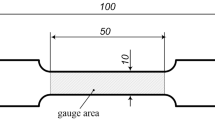Conclusions
-
1.
The velocity of propagation of ultrasonic vibrations can be used as a measure of the strength of as-sintered and plastically worked porous metals.
-
2.
The strength of re-pressed specimens only slightly exceeds that of specimens of the same density produced by single pressing and sintering. This is due to the simultaneous manifestation of a strengthening induced by the work-hardening of the material during plastic working and a strength loss caused by the presence of macroscopical crevice-like defects.
-
3.
By measuring the velocity of propagation of USV it is possible to calculate the strength of an unworkhardened material having the same structure as a worked porous material.
Similar content being viewed by others
Literature cited
I. V. Zashchuk, Electronic and Acoustic Methods of Testing of Building Materials [in Russian], Moscow (1968).
Nondestructive Methods of Quality Control of Reinforced Concrete Constructions [in Russian], Stroiizdat, Moscow (1972).
V. A. Klevtsov, Beton i Zhelezobeton, No. 7 (1969).
R. Jones, Nondestructive Testing of Concrete [Russian translation], Stroiizdat, Moscow (1964).
A. Galan, Stavenicky Casopis,15, 3 (1967).
V. T. Troshchenko and V. N. Rudenko, Strength of Powder Metallurgy Materials and Methods of Its Determination [in Russian], Tekhnika, Kiev (1965).
G. S. Pisarenko (editor), Strength of Powder Metallurgy Materials and Alloys at Normal and High Temperatures [in Russian], Izd-vo Akad. Nauk UkrSSR, Kiev (1962).
A. Ya. Krasovskii and N. A. Filatova, Poroshkovaya Met., No. 11 (1968).
I. M. Storozhevskii, Poroshkovaya Met., No. 9 (1968).
I. M. Storozhevskii, P. G. Arabadzhi, et al., Poroshkovaya Met., No. 11 (1969).
M. Yu. Bal'shin, Dokl. Akad. Nauk SSSR,67, No. 5, 837 (1949).
V. V. Skorokhod, Rheological Principles of Sintering Theory [in Russian], Naukova Dumka, Kiev (1972).
V. V. Skorokhod, M. Ya. Kutser, and G. R. Fridman, Transactions of an All-Union Seminar on Advanced Powder Metallurgy Techniques [in Russian], Minsk (1973).
T. Ya. Benieva, Uses of Ultrasonic Vibrations for the Investigation of Properties, Quality Control, and Processing of Metals and Alloys [in Russian], Izd-vo Akad. Nauk UkrSSR, Kiev (1960), p. 40.
R. H. Brockelman and K. A. Fowler, Intern. J. Powder Met., No. 2 (4), 45 (1966).
G. Artusio et al., Powder Met., No. 17, 89 (1966).
Author information
Authors and Affiliations
Additional information
Translated from Poroshkovaya Metallurgiya, No. 1(157), pp. 83–87, January, 1976.
Rights and permissions
About this article
Cite this article
Skorokhod, V.V., Kutser, M.Y. & Fridman, G.R. Correlation between the strength and acoustic properties of volume-strained porous iron. Powder Metall Met Ceram 15, 67–70 (1976). https://doi.org/10.1007/BF00792414
Received:
Issue Date:
DOI: https://doi.org/10.1007/BF00792414




